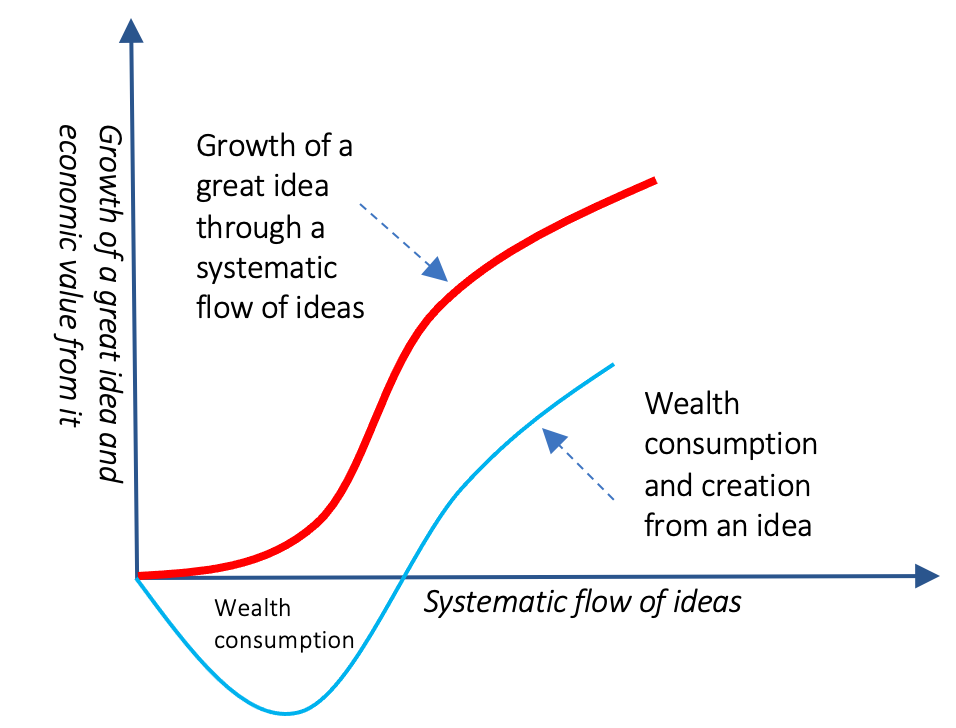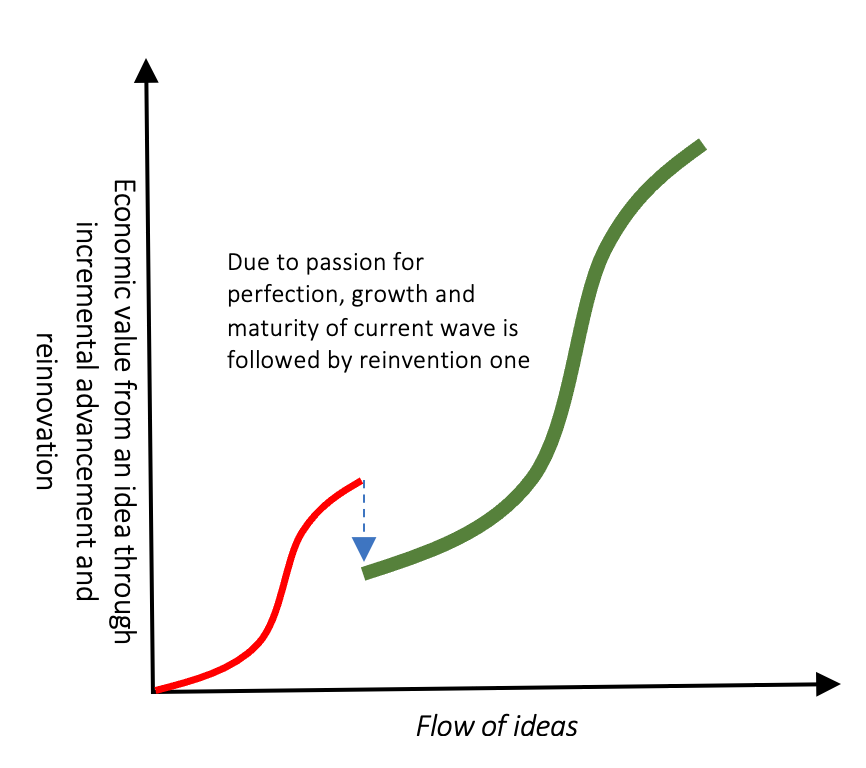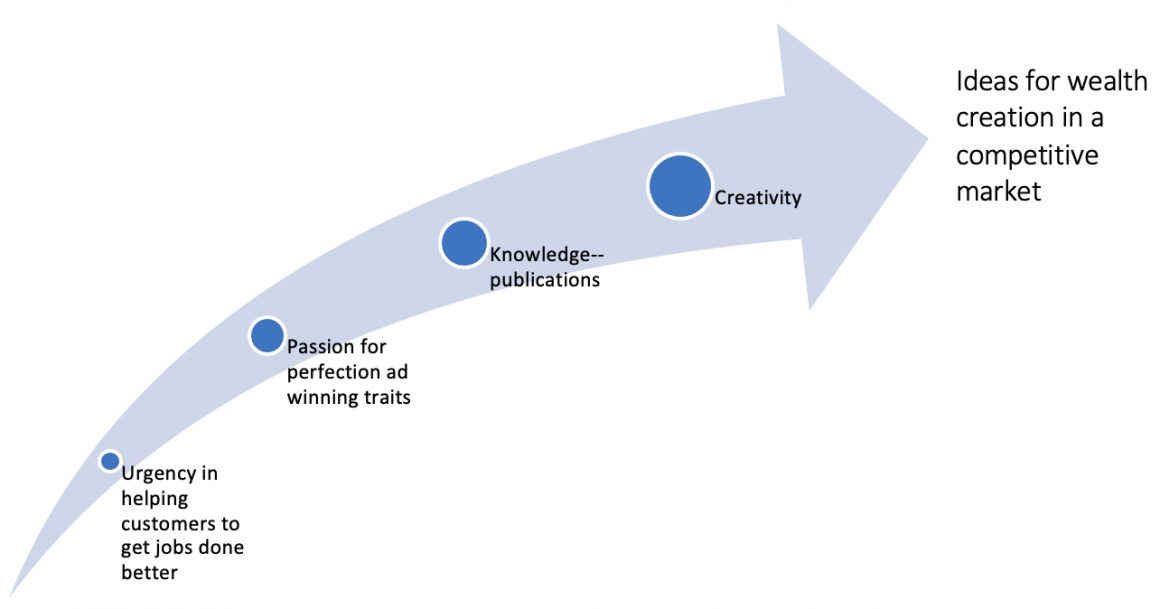Despite having all-time high scientific publications, patent filings, and Startups, why is there a concern for the scarcity of ideas for driving economic growth? Why cannot the astronomical rise of filing of invention patent applications in China, reaching 1.497 million in 2020, be good enough to keep China’s economy on a high growth path? On the other hand, despite showing high growth in Scopus indexed scientific publications and rising position in the global Innovation index, India has been struggling to prevent the economy from slowing down. Besides, researchers are pointing to the scarcity of ideas in driving economic growth. What else is missing? We need passion and knowledge for scarcity ideas.
Ideas are at the core of our ability to create Wealth. They are easy to produce. Brainstorming of what we can do even out of a teaspoon generates 10s of random ideas. But only a couple of them serves a meaningful purpose. Research finds that we are suffering from a growing scarcity of such ideas. Despite the fact that we are setting new records of scientific publications and patent fillings, why are we suffering from a scarcity of ideas? Without Passion for Perfection, the flow of knowledge alone does not succeed in producing ideas to make things better. Our creative minds should be fed with both the passion for perfection and the flow of knowledge to generate ideas. These are the ideas that offer profit-making opportunities by improving products, processes, or both of them. Hence, we need to focus on passion and knowledge for the scarcity of ideas.
Mere ideas are not good enough for economic value creation

There is a saying that necessity is the mother of invention. In the absence of adequate knowledge, necessity alone does not lead to inventive ideas. On the other hand, knowledge itself does not empower minds to produce useful ideas. Once knowledge and passion for perfection or intense desire to find better means are fed into the creative minds, meaningful ideas emerge. Over the decades, there has been a growing resource allocation for sharing and generating knowledge. Unfortunately, our economic growth does not appear to be proportionate to such progress. However, ideas are key for offering us prosperity and driving economic growth.
In addition to great ideas, we need a systematic Flow of Ideas. Inventions like Television, iPhone, or the light bulb have been evolving with a flow of ideas. Invariably, every great idea demands a flow of ideas for unlocking the potential.
Ideas and economic growth
For a long time, economists did not have much clarity about what it takes to drive economic growth. They were, often, busy in refereeing to natural resources, labor, and capital. Upon failing to explain economic growth due to commonly known factors, Prof. Solow referred to science and technology. However, he could not explain well about its specific role. Hence, he termed it as a residual effect. It’s quite ironic to observe that the Market Economy emerged to leverage human beings’ inherent capability of generating ideas for recreating the world around them. Hence, the market economy adopted the principles of ownership of capital and freedom of entrepreneurship to profit from ideas.

Despite having a foundation of the market economy on ideas, recently economists like Paul Romer articulated the role of an idea as an endogenous factor in creating economic outputs. He established that upon taking explicit measures to increase the supply of ideas, we could keep driving economic growth. Hence, we need to have a focus on unearthing the flow of ideas for fueling sustained economic growth. This flow of ideas is at the core of evolution and diffusion of innovations as increasingly growing progressive waves. Hence, profiting from innovation demands a passion for perfection. Furthermore, ideas are vital for reinventing products for creating a new wave of growth, causing creating destruction to less efficient and effective ways in meeting our necessities.
Scarcity of ideas—does it mean that the endless frontier of growth is closing?
Solow’s work during the 1950s concluded that technological progression contributed to as high as 80 percent of the USA’s economic growth. However, his findings did not clarify the way technological change kept contributing. To offer clarification, Paul Romer came up with the metaphor of a recipe of mixing ingredients to cook a meal. He made a point that by improving the recipe, we can produce increasing economic value from the same ingredients. Hence, by increasing the supply of ideas, we can keep driving economic growth. In explaining the source of new ideas and objects, Paul Romer referred to the periodic table. He made a point that we have infinite possibilities of combining natural ingredients. Hence, we have an endless source of ideas.
However, unless and until an idea shows the potential of improving products and/or processes, profit-making firms do not pursue them to integrate into productive activities. Hence, despite endless possibilities of ideas, only those ideas having profit-making potential matters to creating economic value.

Recent research reports find that R&D productivity has been falling. The purpose of R&D has been to produce outputs for producing economic outputs. More specifically, R&D produces ideas for improving products or processes or both of them. Such improvement is vital for increasing quality and reducing cost, thereby increasing as well as sustaining profitability. It means that economic outputs from per unity of R&D investment have been declining. To address it, the USA and other advanced countries have been increasing the number of scientists. Analysis of data indicates, “The economy has to double its research efforts every 13 years just to maintain the same overall rate of economic growth.” Hence, it raises the question of the scarcity of ideas.
China’s Skyrocketing Graduates, Publications, and Patents
One of the inputs of the idea creation process is knowledge. To increase the supply of knowledge flow, the often-practiced policies are to expand education and increase investment in R&D. R&D efforts to produce knowledge. Researchers publish it to claim ownership. The number of publications per year is often taken as a measure of the addition of knowledge to the global repository. This knowledge is used to generate ideas, which are often patented. Hence, there is a tendency to use a number of graduates, publications, and patents as major indicators of measuring the progress or assessing the strength of a firm or country to create economic value out of ideas. Hence, with an aspiration to keep expanding economic growth, China has come up with policy intervention for ramping up the production of graduates, publications, and patents.
However, the economic return from the progress of these indicators is not clear yet. A journey of scientific exploration, as well as idea generation for improving products, may have infinite options to pursue. How to screen them and pursue only those paths which have a high potential of economic return is often a key challenge. In the absence of early screening and pursuing selective options, increasing the supply of funds often leads to the exponential growth of publications and patents. Such a possibility raises the question of the missing element. That missing element appears to be a passion for the perfection of real-life products. However, China’s passion for making the automobile Reinvention successful for dealing with air pollution and opening idea export trade has been progressing well.
Graduates, publications, and patents do not necessarily reflect proportionate economic

In 2016, China published more than Scopus indexed 426,000 publications. This number is hopping 18.6% of the total documented in Elsevier’s Scopus database. As a result, for the first time, the USA, with 409,000 publications, became a follower to China. On the other hand, India surpassed Japan. Does it mean that India’s economy benefits more ideas than Japan? Or, China has been outperforming the USA in innovation? Despite growing publications, why is there a perception that India does not innovate?
It’s also interesting to note that in 2019, China surpassed the United States of America (U.S.) as the top source of international patent applications filed with WIPO. Upon filling 58,990 applications in 2019 via WIPOs PCT system, China has overtaken USA’s 57,840 fillings. Furthermore, China’s IP office secured the top position upon receiving 1.54 million applications in 2018, which is followed by the USA (597,141), Japan (313,567), Korea (209,992), and the European patent office (174,397).
Moreover, China has also occupied the top position in STEM education by producing 1.7 million graduates in 2016, contrary to USA’s 800,000. Does it mean that China will outperform the USA to derive economic benefit from publications, patents, and STEM graduates? Should we focus on Passion and Knowledge for Scarcity of Ideas should get focus in producing those numbers?
Examples from Japan—Passion and Knowledge for the scarcity of ideas
In comparison to China’s skyrocketing number of graduates, publications, and patents, Japan seems to be in a highly inferior state. But in comparison to Japan’s recent success in producing economic benefits from intellectual outputs, China does not appear to have anything to show.
For example, a small company, Nichia, has stunned the world by taking over the global lighting industry. Instead of state subsidy and other means, Nichia’s success is rooted in producing ideas out of the passion of perfection and scientific discovery. In addition to winning a Nobel Prize out Nichia’s R&D effort, Nichia has succeeded in making the LED light bulb as a creative wave of destruction. As opposed to competing in publications and patents, Nichia’s scientific journey was led by the passion for perfection in creating commercial opportunities. Through such success in knowledge generation and idea creation, Nichia has been deriving significant economic benefits from herself, Japan, and the world as a whole.

Similarly, Sony’s intense desire to take over vacuumed tube-based consumer electronics and film-based cameras led to a relentless journey of perfecting Transistor technology and electronic image sensors. This journey produced very focused scientific knowledge, patents, and profit-making business opportunities. Subsequently, Sony emerged as an innovation success story for fueling two major Creative waves of destruction. Along the way, one of Sony’s R&D team members got Nobel Prize in 1974. Furthermore, Sony’s journey also led to a long journey of perfecting lithium-ion batteries. In addition to creating economic success stories, this journey has also led to publications, patents, and winning Nobel Prizes. It underscores the passion and knowledge for the scarcity of ideas.
For addressing the scarcity of ideas, focus on Passion for Perfection and Scientific Knowledge

In order to produce increasing wealth from depleting natural resources, we need to keep increasing the supply of ideas. Despite the skyrocketing number of publications and patents, research finds that the world is suffering from a scarcity of ideas. We have a scarcity in those ideas that offer profit-making opportunities while offering better products at a lower cost. Does it mean that the increase of supply of knowledge alone cannot address the idea of scarcity? Furthermore, the exponential growth of patents is also failing to address the idea scarcity issue. Does it mean that we are in the race of producing ideas that have very little relevance to perfecting products or processes?
We need to feed both flows of knowledge and passion for perfection to our creative minds. So that we generate ideas for producing economic outputs in the market economy. As opposed to producing generic publications and patents, it may be wise to focus on perfecting products and processes through knowledge and ideas. More specifically, the journey of knowledge creation should be guided by the passion for perfecting products and processes to create a profitable opportunity to offer us better means at a lower cost to get our purposes served.



